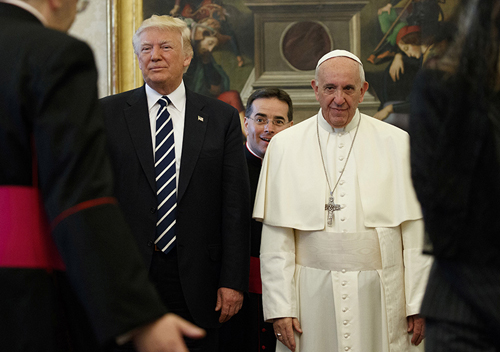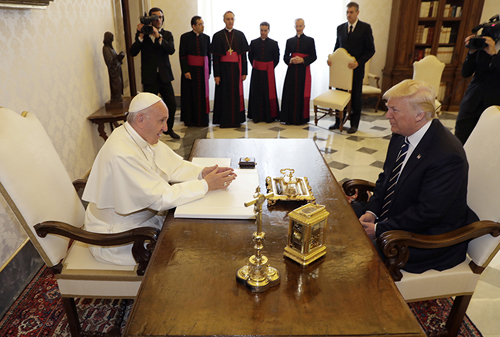
MASSIMO FAGGIOLI, professor of theology and religious studies at Villanova University, in article first published on Religion News Service, reflects on last week’s meeting between US President Donald Trump and Pope Francis…
No matter what their theological inclinations are, Donald Trump’s supporters should be happy with the modern reforms in the Vatican: until a few decades ago a pope would have never received in an audience a twice-divorced, thrice married head of state accompanied by a daughter who converted to Judaism.
Fortunately, this was not a problem for the Trump family accompanying the President in his state visit this week.

President Donald Trump stands next to Pope Francis during a private audience at the Vatican on 24th May. PICTURE: Reuters/Evan Vucci/Pool
The only real news, in fact, was that the passage of the American president through the Vatican was fairly speedy and remarkably uneventful.
This does not mean that nothing of importance happened; on the contrary.
During Trump’s long international trip, the first of his turbulent presidency, the Vatican was the least challenging stop from a strictly diplomatic point of view: but compared to Saudi Arabia and Israel, the first two stops on this “inter-religious trip,” the Vatican was also the most “distant atmosphere,” politically speaking.
What divides Trump from Francis politically does not divide Trump from Saudi King Salman or from Israeli Prime Minister Benjamin Netanyahu. The tension around the meeting with Francis, as opposed to the natural political affinity with the Saudis and Israeli leaders, is more evidence that the President’s pilgrimage was not really about religion.
Instead, it was about figuring out how to use religion for the political purposes of the administration (fighting terrorism, and fueling the anti-Iran complex) without fundamentally changing the narrative of this administration about religion. And that, despite his speech in Riyadh, still centers on an anti-Muslim worldview.
In some sense, the religion of Trumpism is the presidential bending to the politics of white evangelicalism, whose theological substance in America today is in danger of being reduced to the prosperity Gospel.
Trump’s speech failed to acknowledge what had just happened in Iran with the re-election of President Hassan Rouhani, and it offered a parallel to Francis’ speech from Cairo just three weeks earlier: but parallel trajectories by definition do not meet.
The historical, cultural, and theological inadequacy of Trump’s White House has been confirmed by this trip: lucky for Donald Trump, the very formal and structured Vatican protocol gave fewer occasions to show that inadequacy.
The one-on-one meeting in the Vatican with Francis lasted twenty-nine minutes, and the private conversation created some personal connection between them (and the president’s family – for Francis it is always very important to meet the families of his interlocutors). But it did not bridge the gaps between their worldview.
It was an opportunity to familiarize the White House with non-American, global Catholicism – something that is important for the Trump administration, which is far more nationalistic than its predecessors.
It should come as no surprise that some delicate issues, such as climate change, were passed over in the Holy See’s brief official statement; areas of disagreement are never mentioned in this kind of declaration.
Indeed, the fact that it is not mentioned suggests that the gap remains. And it is not the only one. There are some interesting discrepancies between the final communiqué issued by the Vatican and the American delegation about the meeting with the pope and the follow-up meeting between Trump and US officials and the papal Secretary of State, Cardinal Pietro Parolin: the White House statement does not mention immigration, while the Vatican does.
Besides the meetings and the statements, this highly-anticipated summit must be put into a larger context.
First of all, the lowering of expectations during the week before the 24th May meeting signaled the interest by both sides to reconnect after an extraordinarily difficult period of long-range sniping between Trump and Francis.
That quick diplomatic assent was given to the appointment of Callista Gingrich as US ambassador to the Holy See so that it could be announced before the visit showed that the Vatican did not want to exacerbate a particularly delicate relationship.
Second, the expectations for this meeting from each camp were very different.
Trump’s focus was a narrow one: the pope and the Vatican. Trump’s own political interests and moral legitimacy are very different from the Pope’s, and especially from a pope like Francis.

Pope Francis meets US President Donald Trump during a private audience at the Vatican on 24th May 24, 2017. PICTURE: Reuters/Evan Vucci/Pool
On the other side of the desk, Francis had to keep in mind not just the person before him but also various sectors who can be targets of the American president’s actions and policies: the US bishops, American Catholics as a whole, the 1.2 billion Catholics around the world, migrants and refugees whom the pontiff has made a priority for the church, and also other religions – including Islam – who in some way count on the pope to speak truth to the new American power.
Third: the audience also provided some reassurances that the anti-immigration and nativist rhetoric of the Trump campaign was not going to become enshrined in an anti-Catholic presidency in the sense of entrenched hostility to the Pope and the Vatican.
But the distance remains, and it is part of the complex relationship between Rome and the US under Francis.
The Trump phenomenon conquered the GOP – the Party of God in American politics – directly following Francis’ trip to the US in September, 2015. In some ways Trump was, and is, a symptom more than a cause of the difficulties – not just moral-theological (the debate on marriage and family leading to Amoris Laetitia) but also political (the social justice environmental encyclical Laudato Si’) – between Francis and America.
Fourth: Francis’ meeting with Trump was a way for the Pope to send messages to, and about, this administration.
The Pope may have fewer (military) divisions than Trump, but he has more ways to use his soft power. Less than an hour after the end of the meeting with the President, Francis held his weekly public audience in St Peter’s Square with thousands of pilgrims and tourists.
His catechesis during the audience focused on the Gospel passage from Luke about the resurrected Jesus meeting His disciples on the road to Emmaus. But it also served as as way of indirectly reinforcing Francis’ take on this American presidency and its religious claims and appeal.
It would be overly optimistic to expect a sudden change in the relations between the pontificate of Francis and the presidency of Trump due to the miraculous discovery of a previously invisible common ground.
The meeting between Trump and Francis was in fact not an armistice, but a détente.
Massimo Faggioli is a professor of theology and religious studies at Villanova University and a contributing editor to Commonweal magazine





